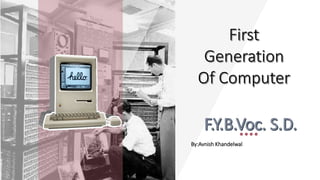
First generation of computer
- 2. The vacuum tube was invented in 1906 by an electrical engineer named Lee De Forest (1873–1961). During the first half of the twentieth century, it was the fundamental technology that was used to construct radios, televisions, radar, X-ray machines, and a wide variety of other electronic devices. It is also the primary technology associated with the first generation of computing machines. Vacuum tubes are glass tubes with circuits inside.
- 3. 3 The main features of the first generation are − Vacuum tube technology Unreliable Very costly Generated a lot of heat Slow input and output devices Huge size Need of AC Non-portable Consumed a lot of electricity
- 4. Generations of first computer: 4 • The first computer to be built in 1946 with vacuum tubes was the Electronic Numerical Integrator and Computer or simply ENIAC. This computer was huge and occupied around 15,000 square feet of floor space and weighed in at an astonishing 30 tonnes! • The second computer in this line was the EDSAC or Electronic Delay Storage Automatic Calculator which had the added capacity to store programs than its predecessor. • The third machine to come along was the UNIVAC or Universal Automatic Computer which was created by scientists John Mauchly and John Presper Eckert and is mostly regarded as the first modern computer. • In 1953 IBM announced their first commercially mass-produced produced computer in the IBM 650. Support for the IBM 650 and its components units was discontinued in 1969.· • The IBM 701 was the last in the line of the first generation computers and was IBMs first scientific computer. The 701 was succeeded by the more advanced IBM 704 in 1956. Some of the computers that made up this generation include:
- 5. During the period of 1940 to 1956 first generation of computers were developed. The first generation computers used vacuum tubes for circuitry and magnetic drums for memory, and were often enormous, taking up entire rooms. The vacuum tube was developed by Lee DeForest. A vacuum tube is a device generally used to amplify a signal by controlling the movement of electrons in an evacuated space. First generation computers were very expensive to operate and in addition to using a great deal of electricity, generated a lot of heat, which was often the cause of malfunctions. FIRST GENERATION OF COMPUTERS 5
- 6. UNIVAC, EDVAC EDSAC ENIAC Examples of first generation of computer Devices 6
- 7. UNIVAC (Universal Automatic Computer) was the first commercially general purpose electronic computer. John Eckert and John Mauchly at the Moore School of Engineering, Pennsylvania developed it in 1951. It was used for the analysis of 1952 Presidential Election in the United States. It was 8 feet high, 15 feet long and weighed 5 tons. It contained 5600 tubes, 18000 crystal diodes, and 300 relays. A magnetic tape was used for data input and output. Universal Automatic Computer (UNIVAC) 7
- 8. John Mauchly and J.P. Eckert also proposed the development of EDVAC. The conceptual design for EDVAC electronic computer to use the stored program concept introduced by John Von Neumann. Unlike the ENIAC, it used binary number rather than decimal. The University of Pennsylvania built the EDVAC for the U.S. Army’s Ballistics Research Laboratory at the Aberdeen Proving Ground. EDVAC had almost 6000 vacuum tubes and 12000 diodes. It consumed 56kW of power. It covered 490 feet square of floor and weighed 7850kg. 8 Electronic DiscreteVariable Automatic Computer (EDVAC)
- 9. EDSAC (Electronic Delay Storage Automatic Calculator) was developed by a group of scientists, headed by Professor Maurice Wilkes at Cambridge University, England, in 1949. It was also based on the stored program concept and one of the first to use binary digits. The input and output were provided by a paper tape. It could do about 700 additions per second and 200 multiplications per second. The machine occupied a room, which measured 5/4 meters. Electronic Delay Storage Automatic Calculator (EDSAC) 9
- 10. Electronic Numerical Integrator and Calculator (ENIAC) was designed by John Mauchly and John Presper Eckert in 1946 at the Moore School of Electrical Engineering, University of Pennsylvania. It was the first electronic computer. ENIAC was initially built for the United States military to calculate the paths of artillery shells. It contained 18000 vacuum tubes, 7200 crystal diodes, 1500 relays, 70000 resistors, 10000 capacitors and around 5 million hand-soldered joints. It weighed nearly 30 tons and consumed 160 kW of power. Input was possible from an IBM card reader while an IBM punch card was used for output. Electronic Numerical Integrator and Calculator (ENIAC) 10
- 11. AdvantagesAnd Disadvantages of First Generation Computer Vacuum tubes have no air inside of them, which protects the circuitry.
- 13. 13 These computers fast and could calculate data in millisecond. Vacuum tubes were the only electronic component available during those days. Vacuum tube technology made possible to make electronic digital computers. Easily available and inexpensive. Tactile sensitivity is preserved. Color-coded for easier and faster identification of readings.
- 15. 15 The computers were very large in size. They consumed a large amount of energy. They heated very soon due to thousands of vacuum tubes. They were not very reliable. Air conditioning was required. Constant maintenance was required. Non-portable. Costly commercial production. Costly commercial production. Limited commercial use. Very slow speed. Limited programming capabilities. Used machine language only. Used magnetic drums which provide very less data storage.